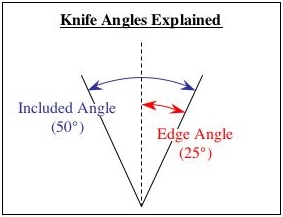Hello,
I have taught about 30 people to freehand sharpen with many of the students seeing and using a whetstone for the first time. As I’ve mentiomed and written about, males have a primal urge to sharpen something, it hits us at some point “The Calling”. Most ignore the urge or at best try sharpening a knife on a grinder of some type. This gets it of their system, they realize there is more to it.
Then there are those who follow up and take some extra steps to learn and they never regret it. How long does it take to start completely from scratch to get the first decent edge, telephone book paper slicing edge?
First thing to know is that you don’t need anything fancy to make it happen, One whetstone , a grasp of the fundamentals, something to put the stone on , some water and some determination. I can say in all honesty that every student could sharpen a knife to a point where it was as sharp as new at the very least and also in every case it took 45 to 90 minutes to reach that stage. If the man in the picture above can sharpen knives using what he has then you can do it.
It really helps to keep a mental picture of what it is that you’re trying to do. It’s pretty simple, bringing both sides of the blade together using a chosen angle on both sides to re-establish the primary edge. It needs to be a continuous line running from heel to tip. The goal is to bring both sides together as precisely as humanly possible, as best as you can at that moment. ( That level of precision and consistency continues to develop over time). With use, the dulling process is underway, when that extremely thin strip of metal, the primary edge is under stress of any type, i.e. normal kitchen chores, the metal fatigues and bends over to the side, any side, both sides. Eventually the stability of the entire primary edge is compromised and the knife is dull. Sharpening involves the removal of this fatigued metal with water stones in my case and again, reestablishing the primary edge using the strong, virgin steel that has been exposed by the abrasive properties of water stone and your sharpening motions.
Angle control becomes the new challenge when learning to sharpen and there is no way to make it easy other than to practice. Find an angle between 10 and 20 degrees per side, you can use your pinky as a quick and easy way to form an angle of about 16 deg. This is fine, you can start building your sharpening muscle memory with this angle, just keep trying to hold the angle, to control the space between the spine of the knife and the surface of the stone. It doesn't matter if the knife was sharpened originally at 19 deg per side, the pinky method just allows you to quickly and easily start the process at a particular angle. It is only your muscle memory, your ability to keep that angle steady that you need to worry about next.
Some folks don't have to much of a problem with this, the key is slow down, focus on the process and try your best to maintain that angle.
The really cool thing about freehand sharpening is that you don't need to have perfect control to get the knife sharp, we are human so 100 percent consistency is a tough goal to reach but again, you can get your first knife sharp by just doing you best to hold an angle,
If you are able to form the burr and more importantly to remove the burr as completely as you can the knife will be sharp. If your angle is 16 deg on one side and 18 on the other with a little wobble in there, it will still work
In most cases with students, within 45 minutes the first knife is sharp enough to slice telephone book paper very nicely and in almost every case the person is blown away by what he or she has accomplished. After this initial boost of confidence, it just gets easier and better.
Expectation Management is important, you don't need to get the knife ready for surgery, just do your best to get it to the point where it is fun to use in the kitchen again and start to feel the satisfaction that comes along with sharpening your own knife..
So if there was three most important points to consider when learning to sharpen:
1. Gain an initial understanding of the fundamentals, just don't pick up a knife and drag it over a stone expecting results. This will lead to frustration and will likely be the first and last time you try. Remember, your goal is to reestablish the primary edge, the sharp part, if you know what you need to do to get that done and if you have the tools than sharpness is inevitable.
2. Don't overthink it, slow down, decrease pressure if things are not shaping up as expected. What takes me 5 minutes to achieve may take you 10 minutes, have patience and steer the course.
3. Don't get hung up on how many water stones to buy and what brands are best and what stone is best for this steel etc. Get at least one good 1000 grit stone and solidify your technique. It really is all about technique.
GOOD LUCK, you can learn to sharpen your own knife.
Peter





No comments:
Post a Comment